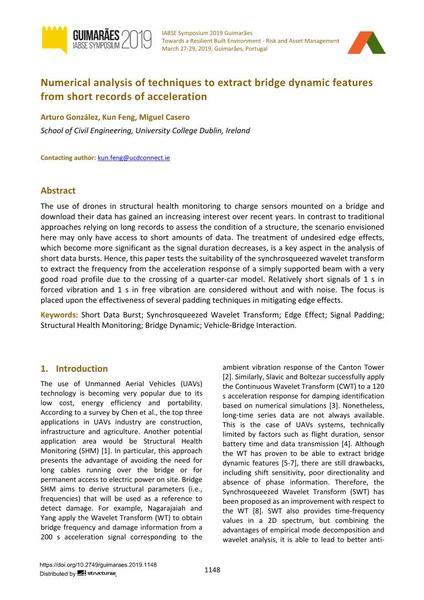Numerical analysis of techniques to extract bridge dynamic features from short records of acceleration

|
|
|||||||||||
Détails bibliographiques
| Auteur(s): |
Arturo González
(School of Civil Engineering, University College Dublin, Ireland)
Kun Feng (School of Civil Engineering, University College Dublin, Ireland) Miguel Casero (School of Civil Engineering, University College Dublin, Ireland) |
||||
|---|---|---|---|---|---|
| Médium: | papier de conférence | ||||
| Langue(s): | anglais | ||||
| Conférence: | IABSE Symposium: Towards a Resilient Built Environment Risk and Asset Management, Guimarães, Portugal, 27-29 March 2019 | ||||
| Publié dans: | IABSE Symposium Guimarães 2019 | ||||
|
|||||
| Page(s): | 1148-1155 | ||||
| Nombre total de pages (du PDF): | 8 | ||||
| DOI: | 10.2749/guimaraes.2019.1148 | ||||
| Abstrait: |
The use of drones in structural health monitoring to charge sensors mounted on a bridge and download their data has gained an increasing interest over recent years. In contrast to traditional approaches relying on long records to assess the condition of a structure, the scenario envisioned here may only have access to short amounts of data. The treatment of undesired edge effects, which become more significant as the signal duration decreases, is a key aspect in the analysis of short data bursts. Hence, this paper tests the suitability of the synchrosqueezed wavelet transform to extract the frequency from the acceleration response of a simply supported beam with a very good road profile due to the crossing of a quarter-car model. Relatively short signals of 1 s in forced vibration and 1 s in free vibration are considered without and with noise. The focus is placed upon the effectiveness of several padding techniques in mitigating edge effects. |
||||
